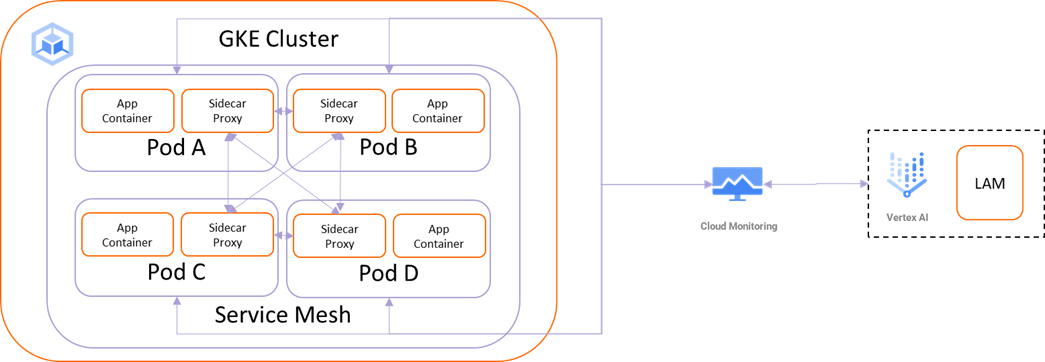The microservices revolution has brought agility and scalability to the forefront of application development. But with this complexity comes a new set of challenges: managing and optimizing the complex web of interactions between services. In service mesh, the invisible control plane provides traffic management, security, and observability for these distributed systems. However, even service mesh can be bogged down by manual configuration, time-consuming troubleshooting, and constant security threats.
Imagine a world where intelligent algorithms, driven by generative AI, seamlessly weave into the complex world of service mesh. Integrating generative AI with service mesh opens up exciting possibilities for enhancing automation, adaptability, and intelligent decision-making within cloud environments. Gen AI can act as a game-changer with its ability to automate, predict, and personalize, propelling service mesh to new heights of efficiency and effectiveness.
Below are few points to consider when integrating service mesh with gen AI.
- Policy Generation and Optimization
- Dynamic Routing and Load Balancing
- Interconnected Microservices
- Predictive Auto-Scaling
- Anomaly Detection and Security Policies
- Monitoring and Insights
- Incident Response
- Continuous Learning and Adaptation
- Use Cases
- Final Thoughts
Policy Generation and Optimization
Generative AI can analyze historical data, performance metrics, and user behavior to intelligently generate and optimize policies within the service mesh. Gen AI can predict optimal configurations for traffic management policies, security policies, resource allocation rules and load balancing. This translates to real-time adjustments based on traffic patterns and resource demands, ensuring your mesh operates at peak efficiency without manual intervention.
Dynamic Routing and Load Balancing
Service mesh relies on dynamic routing and load balancing to optimize application performance. Generative AI can contribute by continuously analyzing network traffic patterns, predicting potential bottlenecks, and dynamically adjusting routing and load balancing configurations in real-time. This ensures optimal resource utilization and responsiveness.
Interconnected Microservices
Service mesh dynamically adapts to changes in the cloud environment, managing load balancing, traffic routing, and service discovery. When generative AI introduces new patterns and outputs, service mesh adapts dynamically to incorporate these changes seamlessly. In short, service mesh becomes the bridge that allows the creative outputs of AI to seamlessly communicate and collaborate.
Predictive Auto-Scaling
Leveraging generative AI's predictive capabilities, service mesh can benefit from intelligent auto-scaling. By analyzing historical usage patterns and anticipating future demand, AI can provide recommendations for scaling resources up or down within the service mesh. By predicting optimal configurations it eliminates tedious manual work and ensures that mesh operates at peak performance. This frees up your team to focus on strategic initiatives, innovation, and driving business value.
Anomaly Detection and Security Policies
Security is the cornerstone of any microservices architecture, and generative AI excels in anomaly detection. By continuously analyzing service mesh activity and network traffic, AI models can identify suspicious patterns and potential threats.
Integrated with service mesh, Gen AI learns from every past attack and threat intelligence report. It can dynamically adjust security policies, initiate preventive measures, or isolate affected services to ensure the integrity and security of the overall system and will be able to predict and prevent breaches before they happen.
Observability and Insights
Service mesh relies on observability to monitor and analyze application performance. Generative AI can enhance observability by providing deeper insights into complex patterns and correlations within the mesh. Gen AI can predict potential issues before they arise, enabling proactive maintenance and minimizing downtime.
Incident Response
During incidents or service disruptions, generative AI can collaborate with support teams through the service mesh. AI can analyze incident data, identify anomalies, and propose potential resolutions, through natural language interfaces, support teams can interact with AI to diagnose issues, receive recommendations, and initiate remediation actions, streamlining the troubleshooting process.
This will help in accelerating incident response, minimizing downtime and optimizing the overall system resilience.
Continuous Learning and Adaptation
Service mesh dynamically adapts to changes in the cloud environment, managing load balancing, traffic routing, and service discovery. AI can adapt and evolve based on real-time feedback and changing environmental conditions. Whether it's learning from user interactions, system performance, or evolving security threats, the AI-driven service mesh becomes a dynamic and self-optimizing ecosystem.
Observability and Insights Explained:

As mentioned above Gen AI models are trained on the past configurations, issues faced, and the corrective action taken on those issues.
As shown above in the diagram, cloud monitoring continuously sends updated information (logs, issues etc.) to Vertex AI where models are updated based on the latest information received. Gen AI can continue evaluating the information in real time and predict potential issues before they arise, enabling proactive maintenance.
Gen AI can also provide the configuration recommendations best suitable to optimize performance and cost.
Final Thoughts
The integration of generative AI with service mesh opens up a possibility of use cases across various industries. Integration with service mesh is one of them.
The integration of generative AI with service mesh creates a powerful synergy, enhancing the adaptive and intelligent capabilities of cloud environments. By leveraging generative AI's predictive analytics, anomaly detection, and continuous learning, service mesh becomes a more responsive, efficient, and secure orchestration layer in hybrid and multi-cloud architectures. The result is a win-win situation where AI augments the capabilities of service mesh, contributing to a more resilient, adaptable, and intelligent cloud ecosystem.
The integration of generative AI with service mesh is still in its early stages, the possibilities are endless. As technology matures and challenges are addressed, we can expect even more innovative use cases to emerge, transforming service mesh into a self-optimizing, AI-powered control plane.


